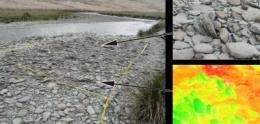What lies beneath: Study examines sediment movement during floods in rivers

Food disasters in many parts of the world have brought into sharp focus new research spearheaded by the University of Leicester on the behaviour of rivers during periods of high flow.
Using an innovative combination of techniques, the researchers aim to examine precisely how the flow of river water affects the movement of sediment along river beds. They will use lasers to measure changes in the bed of an artificial water channel to devise new techniques that will help predict sediment erosion and deposition in rivers - and thereby identify areas where action should be taken to avert damage to infrastructure such as bridges, road and rail links and power and pipe lines.
Led by Dr Mark Powell from the University of Leicester Department of Geography, the research is being supported by a £604,000 grant from the Natural Environment Research Council (NERC). Partners in the study are Dr Nick Tate, also from the University of Leicester, Dr Stephen Rice and Professor Ian Reid of Loughborough University and Dr Jo Wood of City University, London. The research aims to enhance scientists' understanding of how sediment is carried in rivers during a flood.
Dr Powell said: "Our research is largely associated with the transport of coarse-grained sediment.
"In these types of rivers, the gravel and pebbles which make up the bed and banks move by rolling, sliding or bouncing along the stream bed. Movement of this size of sediment is associated with problems of the stability of the river channel and can have serious environmental and social effects. In cases where large amounts of sediment are deposited from a stream into a river, this can lead to loss of river channel capacity and increase the probability of flooding to adjacent land and properties. On the other hand, where excessive amounts of sediment are washed away from river, there is a risk that banks and bridge piers may collapse.
"The laboratory tests will improve our understanding of sediment movement by flood water and will have benefits for hydrologists, engineers, environmentalists and many other people who live or work on or near rivers."
The researchers say that predicting how sediment is carried in streams and rivers is difficult because a river bed is a complex arrangement of grains.
Says Dr Powell. "River gravel varies widely in size, spacing, packing and the geometrical arrangement of individual particles, and river beds often develop small-scale, temporary structures such as pebble clusters.
"Although these characteristics determine the amount of sediment that can be moved by a river, surprisingly little is known about the structural properties of river bed sediments, how they develop and how they influence the processes of water flow and sediment transport."
The researchers will use an artificial channel in a laboratory to simulate river flow under controlled conditions. A high precision laser scanner will be used to model the bed of the artificial river, including the size and arrangement of the grains from which it is made.
The flow over the bed will be measured using fluid visualisation - a technique that uses a laser to track the motion of very small neutrally buoyant particles suspended in the flow. The technique will allow the scientists to study how the flow of water changes and is changed by the shifting bed sediment. Finally, a device at the downstream end of the flume will trap sedimentary particles being rolled along the 'river' bed so that their characteristics can be identified.
"This innovative combination of measurements has not been made before," says Dr Powell. "The study represents an important opportunity to better understand how bed material character controls sediment movement in rivers."
The research is announced as the University of Leicester celebrates Big Green Week (October 25-31) which launches the University's commitment to carbon reduction. The primary aim under carbon reduction is to achieve an absolute reduction of 60% of the carbon emissions of the University by 2020.
Provided by University of Leicester















